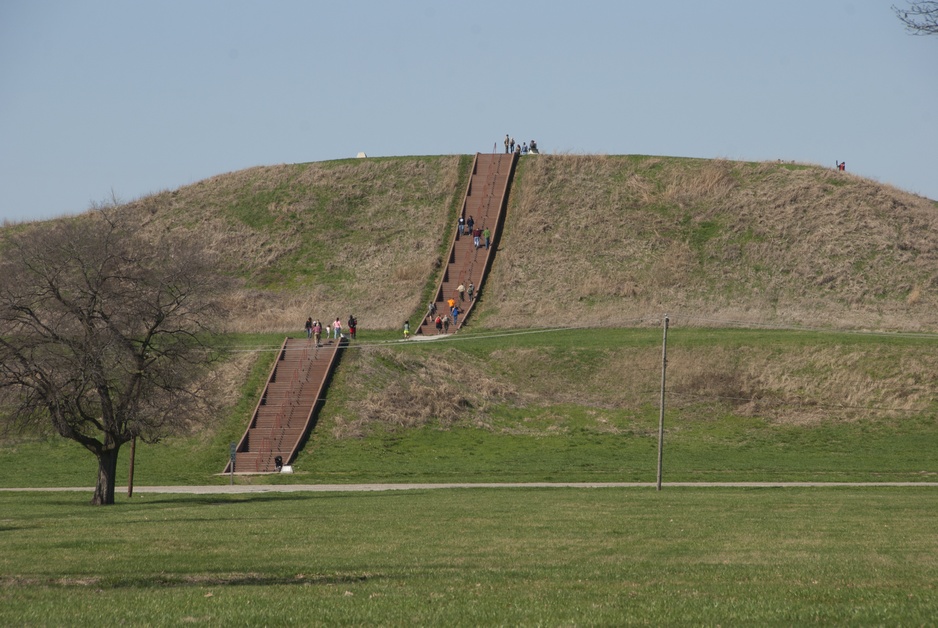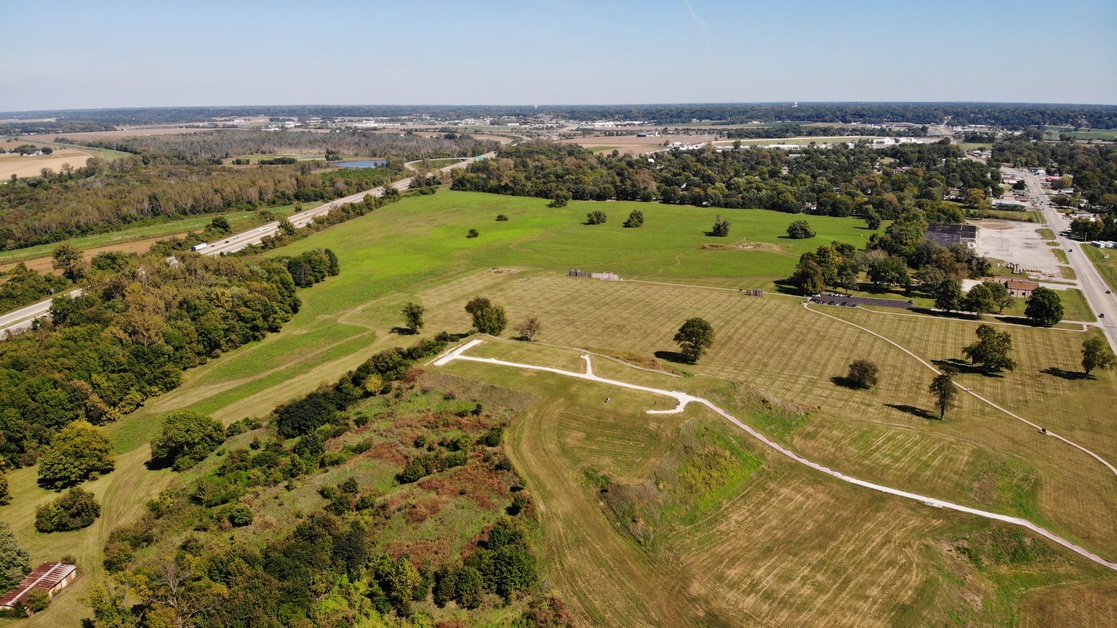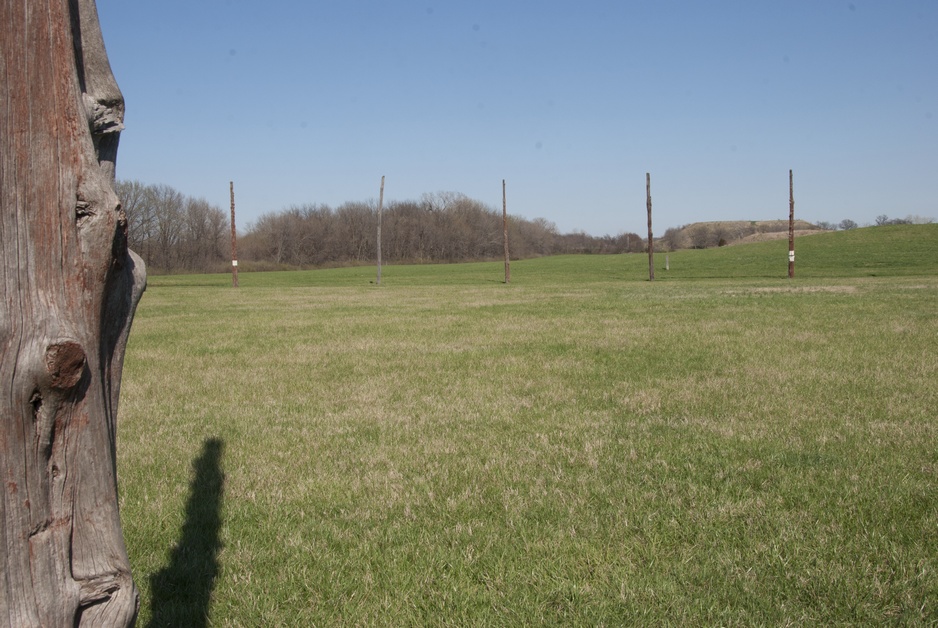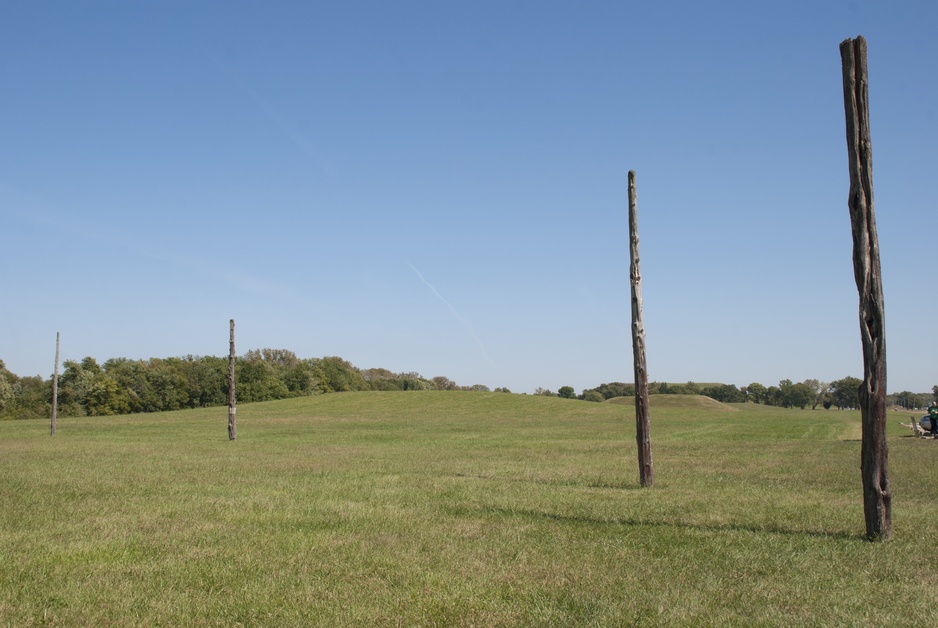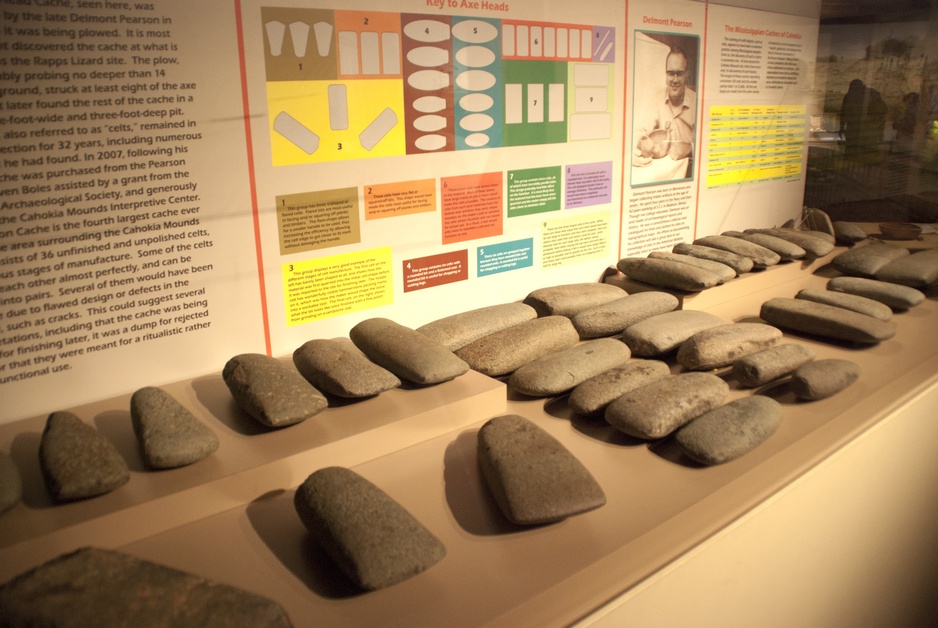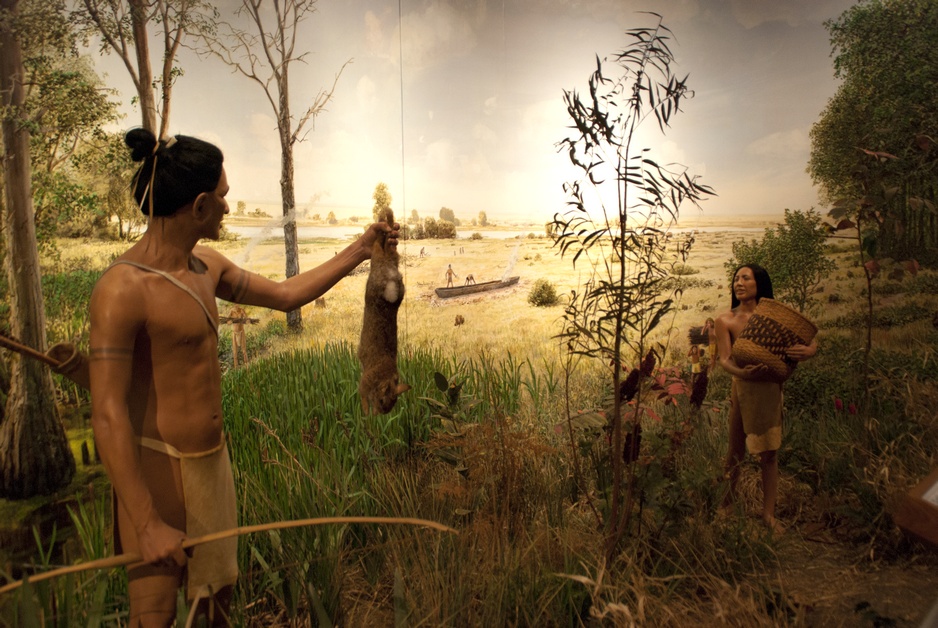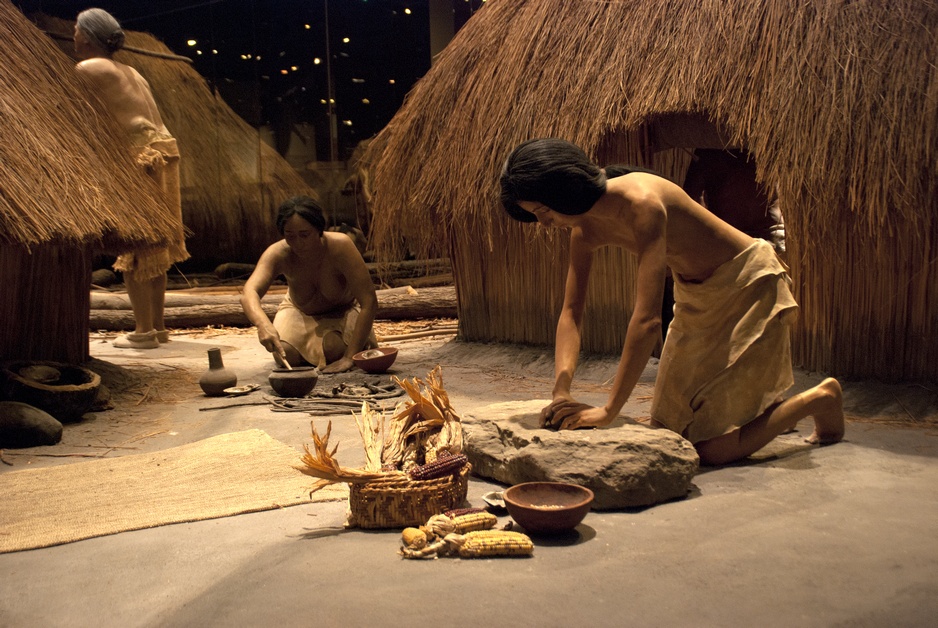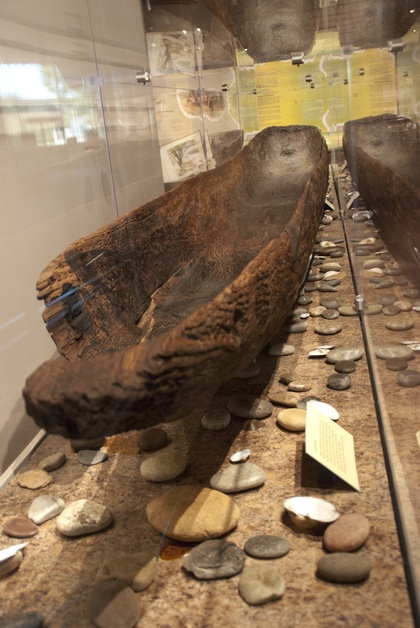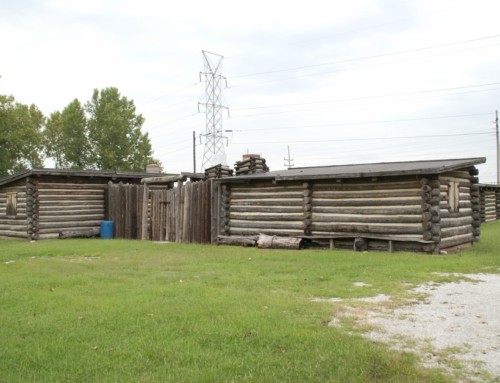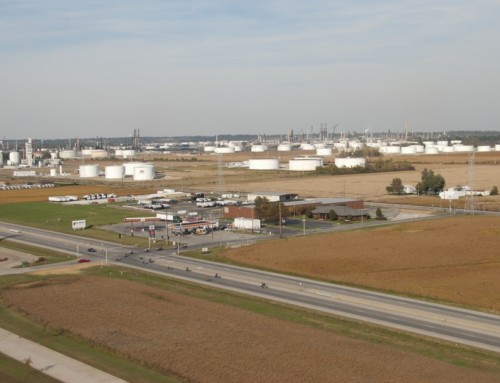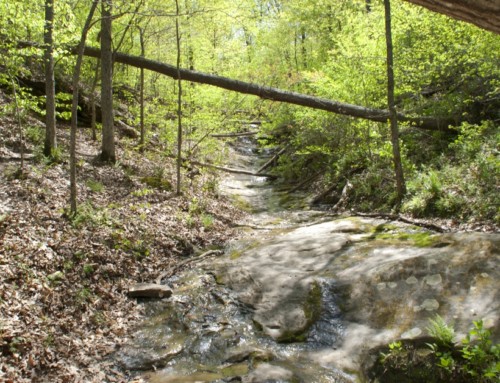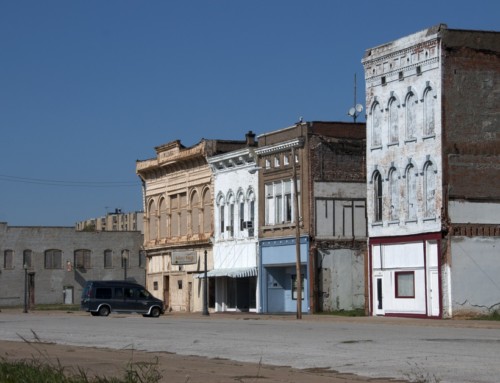Population (1200 CE)
20,000

Introduction
If the Mississippian culture had built with stone instead of dirt, their civilization would be as famous as the Mayans and draw crowds of tourists like Angkor Wat. Instead, we collectively ignore or remain ignorant of the sophisticated civilization that dominated much of the Mississippi Valley for centuries. That’s a shame.
The Mississippians built flat-topped mounds (or pyramids), cultivated corn and other crops in the rich floodplain of the Mississippi River, developed a sophisticated social order with advanced science and art, and connected to much of North America via a vast trade network.
The story of the city at the center of Mississippian society may not unfold as quickly as at other ancient sites but give it time and you’ll be rewarded.
Visitor Information
Contact Cahokia Mounds State Historic Site directly (618.346.5160). NOTE: The site’s interpretive center is closed for renovations until late 2024.
History
The area called the American Bottom stretches 70 miles in Illinois from Alton to Chester. The wide and fertile flood plain is the product of the merging of three big rivers: the Missouri, Mississippi, and Illinois. It’s no wonder why the area has attracted settlers for at least 12,000 years.
Paleo-Indians hunted and lived in the area, probably for centuries. Indians in the Woodlands era flourished along the Ohio River and up the Mississippi. They built thousands of mounds, cultivated crops, developed the bow and arrow and the flint hoe, and influenced centuries of religious practices.
The climate in the region warmed around 1,200 years ago and stayed more temperate and wetter for four centuries. These changes improved conditions for agriculture, which may have contributed to the rapid growth of Mississippian culture.
Rise of Mississippian Civilization
We aren’t sure if Mississippians came from somewhere else or were descended from Woodland people. The area where they put down roots, though, had relatively easy access to key resources that helped to fuel their growth.
The Ozark mountains to the southwest provided chert for arrowheads, hoes, and other tools. The prairies to the north and west produced grasses that were harvested for building construction. Forests to the east provided a bounty of nuts, berries, and game, plus hardwood trees for tools, fuel, and building materials. The bottomlands had salt licks, its own variety of edible plants (like cattails), and tall trees for dugout canoes. The river itself yielded a bounty of fish and waterfowl.
What they lacked nearby they traded for. They got copper from the upper Great Lakes, sea shells from the Gulf Coast, and mica from Appalachians. At their peak around 800 years ago, their culture spread throughout the Mississippi Valley and the southeast US, reaching north to Red Wing, Minnesota, and down into Florida.
Beginning around 1200 years ago, the population grew rapidly in the American Bottom. Corn was king, perhaps the single most important food product and the biggest factor that enabled the growth of permanent settlements that grew increasingly complex. It helped that they also developed tools that greatly improved the efficiency and yield of corn crops.
White-tail deer were also abundant, which is probably why they became the single most important animal for the Mississippians. No part of the deer was wasted. They ate the flesh and carved the antlers into arrowheads and tools. Bones were transformed into awls, fishhooks, and scrapers. Hooves were ground up and used for medicine and glue. Even the brain had a special use. It was mixed in with other liquids to soften the hide, so it was more flexible.
For the most part, the city didn’t grow haphazardly. It was carefully planned and divided into areas designated for specific purposes. The core city was laid out in a diamond shape that spread over five square miles with Monk’s Mound in the center. About half of the land was flooded regularly, so it wasn’t used for homes or agriculture. At its peak, some 20,000 people lived in the city, with many more in other cities in the area. Cahokia proper may have had a population density as high as 4,000 people per square mile, which is just a little less than Miami (4,323) and Philadelphia (4,337) today.
At the center of the city, Mississippians built a large plaza where people gathered for public events, games, markets, and festivals. The most important monuments and neighborhoods were concentrated in the city center. Other neighborhoods radiated out from there, each anchored by a smaller plaza of its own. Walkways connected the different parts of the city.
Mississippian agriculture was so successful that they fed thousands of people and still had surplus to trade. The reliable food source also gave them the time to develop art (including music and dance), to play games like chunkey, and to develop new technologies and more complex religious rituals. Mississippians made extensive use of pottery, creating different types of vessels for different purposes and adding mussel shells as a tempering agent. Tattooing was common for men and women. If they had a writing system, we haven’t found it, yet.
One of their more remarkable feats was their ability to call upon and organize thousands of laborers for construction projects, most notably for earthen mounds (or pyramids; they are basically the same kind of structure). Each mound was built from soil excavated with hand tools and carried in baskets to the construction site. Cahokia once had as many as 120 mounds, which is a heck of a lot of dirt to move! There are 68 surviving mounds at the historic site today. The Mississippians built three types of mounds: conical, ridgetop, and platform.
Conical mounds were generally used to bury elite members of the society; regular folks were buried in cemeteries. Of the six surviving ridgetop mounds, four appear to mark boundaries. The excavation of one—Mound 72—revealed the remains of an elite leader who was laid to rest on top of thousands of shells arranged in the shape of a falcon. Dozens of other remains were found in the same mound, people who were probably killed as part of a ritual sacrifice.
Platform mounds are one of the defining features of Mississippi culture. They usually had a structure on top of the highest level—a building for religious ceremonies, homes for leaders, or buildings where the dead were prepared for burial (charnel houses). The grandest structure, Monk’s Mound, dominated the central part of the city. It was built and expanded a few times over three centuries and is remarkable not only for its scale but also for the engineering required to pull it off. It’s not just a bunch of dirt piled high and compacted. Mississippians used different types of soil in different places to maximize drainage and stability.
Area rivers played an important role in the lives of Mississippians. Apart from the food they provided, the rivers offered a reliable means of getting around. Cahokia Creek, which is barely noticeable today, once provided a water connection to the Mississippi River. Mississippians navigated the rivers in dugout canoes that ranged from 12 to 70 feet long; they were usually carved from a single tree (bald cypress, poplar, or cottonwood were commonly used). Creating a dugout canoe was an arduous process. First, the tree had to be burned in the middle; clay was placed on the areas that they wanted to remain intact. After the fire was put out, canoe builders used a stone or shell to scrape out the charred sections, repeating the burning and scraping until they had achieved the basic shape. They’d finish construction by using a chert adze to trim the canoe into its final form.
While Cahokia was the center of Mississippian culture, they had many satellite communities in the area, including where St. Louis and East St. Louis are built today. Later in the city’s development, the central part of the city was enclosed with a fortified wall (beginning around 1150 CE). Other Mississippian cities built palisades around the same time, which suggests that the leaders felt a need to defend themselves from something, but there’s no evidence that the city was ever attacked.
Collapse of the City
By 1250 CE, Cahokia had lost steam, although there’s no obvious reason for the decline. There is no evidence of a major precipitating event like an epidemic, invasion, or natural disaster. It’s likely that the city’s population just grew too big and exhausted the resources in the area.
For example, the city relied on massive amounts of wood for construction and for fuel. This almost certainly led to extensive deforestation in the area. The denuded land would have eroded more easily, causing river beds to fill in with silt and flood more frequently. The thousands of wood fires probably created a cloud of air pollution over the city that just got worse as the city grew bigger.
The population of Cahokia probably had some health problems, anyway, because of their reliance on a diet that was high in carbohydrates and low in protein. Many people appeared to suffer from anemia and malnutrition, for example. There’s also evidence that the climate began to cool around the time of the city’s decline, which might have reduced the yields of the crops they grew by shortening the growing season.
Ultimately, it looks like people just gradually moved away. By 1400 CE, the city was just a shell of its former self. Mississippians didn’t disappear, though. Even after Cahokia’s decline, Mississippian communities continued to thrive in other places. When Hernando de Soto invaded North America, he and his marauders encountered American Indians who were clearly part of the Mississippian tradition. In addition, the Natchez Indians were also part of the Mississippian tradition; they survived until the French wiped them out in the 1730s. It’s likely that other Mississippians spread out and joined other American Indian communities.
After the Mississippians left Cahokia, other groups moved in, apparently as soon as just a few decades after the city had mostly depopulated. Even though the environment must have still been recovering from centuries of overharvesting, the American Bottom still had much to offer. A group of Oneota Indians built a small village near Cahokia where they lived until around 1600 CE. They were probably ancestors of Kansa, Winnebago, Missouri, Oto, and Iowa Indians.
In the 17th century, some Illini Indians (Kaskaskia, Tamaroa, and Cahokia) moved into the area. The name for the city therefore comes from a group of Illini Indians who were living nearby when French missionaries arrived in the 1700s. Another century later, French Trappist monks established a community on the site (from 1809-1813). They planted gardens on largest mound at a time when the area’s population was growing again, so folks started calling that big structure Monk’s Mound.
The history of the Mississippian city we call Cahokia is fascinating, not just for how it blows up so many ideas we may have about the people who lived in North America before European colonization, but also for the mysterious way it declined.
A Quick Post-Script
For a long time, we have assumed that Cahokia was the only large, pre-Columbian city in North America. We were wrong. Recently, archaeologists have found evidence of another large city that grew around the time that Cahokia was declining. It was built along the Arkansas River near today’s Arkansas City, Kansas, and flourished from roughly 1450 to 1700 CE. It’s likely that this city was the one that Spanish conquistadors called Etzanoa, another North American city that had as many as 20,000 residents.
Who knows what other ancient North American cities we’ve plowed over or under?
Exploring the Area
The Interpretive Center (Collinsville, IL: 30 Ramey Street; 618.346.5160) has several exhibits that help bring to life the old city. A 15-minute movie gives a good overview of what we know about the ancient city. The bulk of the center has exhibits that illustrate different aspects of Mississippian civilization and an impressive life-size diorama that recreates village life around its peak 900 years ago. The Interpretive Center is open Wednesday through Sunday (9-5), but you are free to wander the grounds from dawn to dusk. There is no charge for either, but visitors are encouraged to leave a donation to help keep the site open, something that the State of Illinois has had a hard time doing in the past.
NOTE: The site’s interpretive center is closed for renovations until late 2024, but you are free to walk around the grounds.
I strongly suggest that you take a guided tour of the grounds or rent an audio-tour to get a good feel for the scope of the city (see below).
If you have limited time, make sure you visit Monk’s Mound and Woodhenge.
Monk’s Mound is the largest pre-historic earthen construction and one of the tallest pyramids in the Americas. It tops out 100 feet above the flood plain, stretching out over 14 acres. Built in stages over 300 years, it anchored one end of a grand plaza and had a large structure atop the highest level, probably a temple. Wooden steps were places where the staircase rises today. French Trappist monks established a community around the mounds in the early 1800s, which is where the name comes from.
Just south of Monk’s Mound, Woodhenge is a fairly recent discovery, unknown until highway construction in the 1960s disturbed the site. Archaeologists believe the structure was a sun calendar used to track the seasons and guide decisions about when to plant and harvest crops. The structure was rebuilt as many as five times, with each new construction adding twelve posts to the circle. The current reconstruction was completed in 1985 to recreate the circle as it existed around 1100 AD. It is 410 feet in diameter, with each post about 27 feet apart. The center post was placed 5 ½ feet from the exact center, so it would align properly with the sun cycles at this latitude. The posts marked with a single stripe indicate the location of the summer and winter solstice, while those with two stripes mark the equinoxes. On the equinox, the sun rises up from behind Monk’s Mound, which was almost certainly no accident.
- Tip: The St. Louis Art Museum in Forest Park also has a good collection of Mississippian artifacts, although many aren’t on permanent display.
Tours
One-hour guided tours of the grounds are offered through much of the year. From June through August, they start at 10:30 and 2:30 from Wednesday through Saturday and at 12:30 and 2:30 on Sundays. In April, May, September, and October, tours run on Saturdays and Sundays at 2:30.
If you want more freedom to explore at your own pace, you can also rent an audio tour.
Entertainment and Events
Cahokia Mounds State Historic Site hosts a number of events throughout the year. Some celebrate celestial milestones like the equinox and solstice, while others highlight American Indian culture, and one even showcases the skill of throwing the ancient weapon known as the atlatl. Consult the Cahokia Mounds calendar to see what’s going during for your visit.
**Cahokia Mounds and nearby places are covered in Road Tripping Along the Great River Road, Vol. 1. Click the link above for more. Disclosure: This website may be compensated for linking to other sites or for sales of products we link to.
Where to Eat and Drink
You can buy snacks from vending machines at the Interpretive Center, but there’s otherwise no food on-site. The nearest restaurants are in neighboring Collinsville and Fairmont City, Illinois, like Tienda Y Restaurante El Ranchito (Fairmont City: 2565 N. 32nd St.; 618.875.1521), which serves up an extensive and tasty selection of Mexican cuisine; the seafood options are especially good.
Where to Sleep
If you want to stay nearby, you’ll find a cluster of chain motels in Collinsville along I-55/I-70 at the exit for Highway 157. Downtown St. Louis is only a 15-20 minute drive, though.
Where to Go Next
Heading upriver? Check out Brooklyn.
Heading downriver? Check out East St. Louis.
Community-supported writing
If you like the content at the Mississippi Valley Traveler, please consider showing your support by making a one-time contribution or by subscribing through Patreon. Book sales don’t fully cover my costs, and I don’t have deep corporate pockets bankrolling my work. I’m a freelance writer bringing you stories about life along the Mississippi River. I need your help to keep this going. Every dollar you contribute makes it possible for me to continue sharing stories about America’s Greatest River!
Cahokia Mounds Photographs
©Dean Klinkenberg, 2024, 2021, 2018,2013,2011


